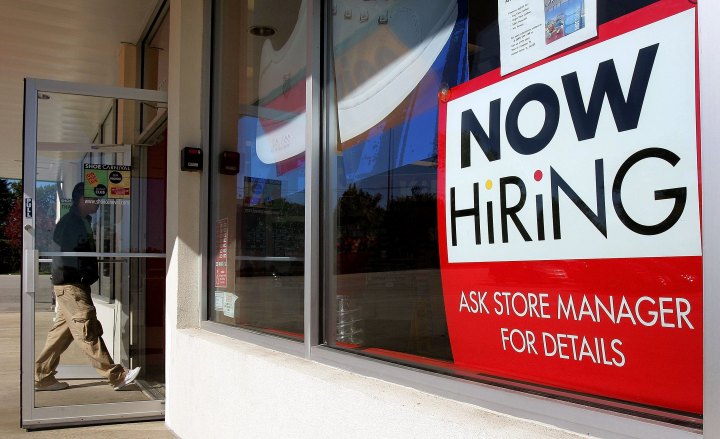
Is the “Great Resignation” actually normal for the labor market?
Is the “Great Resignation” actually normal for the labor market?

Last week, the Bureau of Labor Statistics reported 4.4 million people quit their jobs in February, another near-record high. Despite the high level of departures, an Economic Letter from the Federal Reserve Bank of San Francisco argues that what we sometimes call the Great Resignation is common during rapid economic recoveries like the current one, adding that the trend doesn’t reflect a major change in attitudes about work caused by the pandemic.
Marketplace’s Amy Scott spoke with Bart Hobijn, author of the letter. Hobijn is a visiting fellow at the San Francisco Fed and an economics professor at Arizona State University. The following is an edited transcript of their conversation.
Amy Scott: So we’ve been hearing for months now that this so-called Great Resignation is unlike anything we’ve seen before. But looking back, you found it’s not actually that unprecedented. What’d you find?
Bart Hobijn: I found that in previous fast recoveries of the labor market, there are also large numbers of people that quit. So that a Great Resignation, as we’re seeing now, is actually historically more common than we think it is. And the reason that we haven’t looked at that in detail is because the data on the quits rate that we’re looking at started to be published in 2000. But before that, there were other surveys done by the Bureau of Labor Statistics for the manufacturing sector that showed that similarly to now, in fast recoveries after recessions, quits rates were very elevated in the manufacturing sector.
Scott: And what explains that? Is it just people leaving jobs for better wages as the economy recovers?
Hobijn: Yes. Once a firm starts quickly rehiring people, they don’t only hire people from out of unemployment or people who are not participating in the labor market. They’re also recruiting people from other employers. So we’re having basically people do more musical chairs in the labor market at the moment, switching from job to job. And that gives them more bargaining power to negotiate for higher wages as well.
Scott: You also looked at, you know, who is leaving their jobs and why. And without getting too much in the weeds of the data, I’m wondering what you found that, once again, complicates the narrative that the pandemic made a lot of people, you know, rethink what they’re doing, want different kinds of work, maybe more flexible or remote work, for example.
Hobijn: Yeah. So we can mostly see who left their job or who quit. It’s not perfect, but we can use the same data that’s collected to figure out what the unemployment rate is and look at what people respond on that survey, whether they’re switching jobs or not. And that’s disproportionately less educated workers in sectors that have been hit hard by the pandemic, so you’re thinking about accommodation and food services and retail. You see much less in the data that it’s high-skilled workers. For example, what comes up a lot is tech employees figuring out that they want to have a different life arrangement. But actually, they would be working in professional and business services, where we’re not seeing such a high spike in quits rate.
Scott: So if this isn’t the Great Resignation, like a lot of people have been calling it, how do you understand this moment?
Hobijn: This is, in large part, just a sign of a very fast labor market recovery, which has been good. We could have been stuck in the depths of the pandemic for a much longer time. The main driver is really just firms rehiring workers. It’s not workers really rethinking what they want to do careerwise in the long run.
Scott: But this idea of the Great Resignation is so powerful. I mean, narratives really catch on, and they’re hard to let go of, right, even if the data contradicts it. And I’m wondering, I mean, anecdotally, I think a lot of us know people who’ve had a big rethinking, they’ve moved, they’ve changed jobs. In some cases, I think anecdotes speak louder to us than data. But why does it matter whether this is just a normal, if exaggerated, pattern, or not?
Hobijn: Well, if we would really think about this as being a major shift in the labor supply, then we would also really think about a much bigger need to reorganize everything we do in the economy. What this evidence suggests is that some of this is actually more indicative of a cyclical adjustment than the story of people making long-run changes to what they want to do. I want to emphasize, always there’s people who rethink their careers. There’s nothing new about that. And maybe we’re seeing that being expressed a little bit more vocal during this period, especially in the wake of the pandemic. But it’s not what’s driving the high quits rate.
There’s a lot happening in the world. Through it all, Marketplace is here for you.
You rely on Marketplace to break down the world’s events and tell you how it affects you in a fact-based, approachable way. We rely on your financial support to keep making that possible.
Your donation today powers the independent journalism that you rely on. For just $5/month, you can help sustain Marketplace so we can keep reporting on the things that matter to you.











